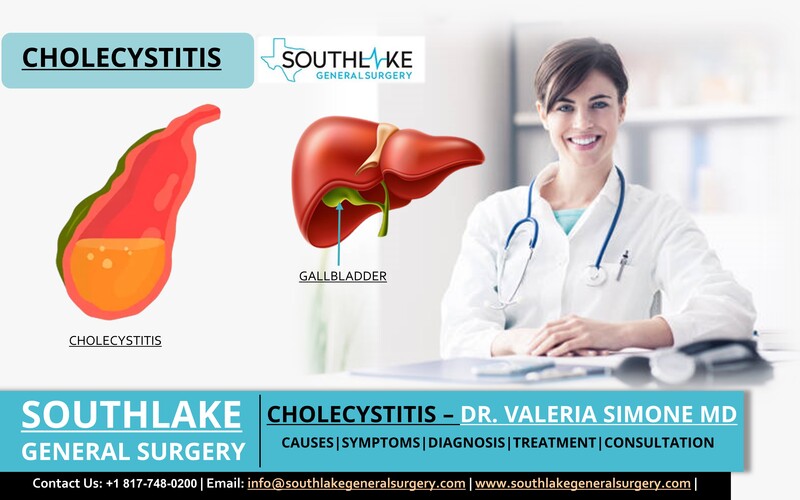Irritation and swelling of the gallbladder refer to Cholecystitis. It can be of two types Acute Cholecystitis and Chronic Cholecystitis.
The gallbladder stores bile and releases it into the small intestine to break down the fats whenever your body needs it. If this passage to the small intestine gets blocked, and bile stuck in the passage can irritate the gallbladder due to stored bile. This condition leads to cholecystitis.
It is important to consult a doctor and get the treatment else it can develop a serious infection. The most common treatment for this condition is gallbladder removal surgery.
Symptoms of Cholecystitis
An individual may experience sharp pain in the upper right section of the stomach. An individual may also experience pain in the back or underneath the right shoulder blade. Cholecystitis symptoms may include:
- Bloating
- Fever
- Vomiting and Nausea
- Light-colored stools
- Change in skin and eyes color to yellowish (jaundice)
Your symptoms may get worse after a high-fat meal. In case you are experiencing discomfit and pain is intense immediately contact the medical emergency services.
Causes of Cholecystitis
The common reason for stored bile is that gallstones, the lumps of bile change into solid and obstruct the path to the small intestines. In the U.S, gallstones are usual and about 10-20 percent of people have them. About 50 percent of Americans with gallstones will develop cholecystitis.
There are other factors too that contribute to cholecystitis, that includes:
- Gallbladder Sludge – It is a thick fluid gathered in the gallbladder. It usually develops in pregnancy or rapid weight loss.
- Blood circulation – A lack of blood supply to the gallbladder such as individuals with diabetes may face these issues.
- Infection – An infection can influence the gallbladder such as bacteria can harm the system that drains bile, leading it to hold up.
- Tumor or Cancer – It can obstruct the bile route. A build-up in the liver or pancreas may stop it from draining.
Risk Factors of Cholecystitis
An individual may have a higher probability of getting cholecystitis if:
- The age of women is more than 50 years and men is older than 60 years.
- You are pregnant
- You are overweight
- You have diabetes
- You are taking a diet high in fat and cholesterol
- You have a heart problem
- You lost weight rapidly
- You have hyperlipidemia (excess amount of lipids in the body)
- You are at the last stage of kidney disease
Diagnosis of Cholecystitis
To diagnose cholecystitis, the doctor will examine your health condition by asking a few questions related to your symptoms and prescribing some blood tests.
Your blood test reports can help identify any sort of infection in the body and the functionality of the liver. Your doctor may like to prescribe for an imaging test, that includes:
- X-ray of the abdomen.
- Ultrasound to examine the gallbladder and liver.
- CT scan is used for a detailed examination of the internal organs of the body.
- ERCP, in this test doctor, uses a long tube that inserts from the throat to the stomach and into the small intestine to examine the bile flow through the system.
- HIDA scan to examine any blockage in bile flow and check the gallbladder movement.
- PTC is used to examine the movement of bile through your body.
Treatment of Cholecystitis
If an individual is experiencing cholecystitis, mainly acute cholecystitis issues then you might need to stay in the hospital for some time. The doctor will advise you to give rest to your stomach and stay on fluids that will be given through a tube connected with a vein. Your treatment may include medicines for pain and antibiotic for any infection.
In case you experience problems because of gallstones, your doctor might try to dissolve them through medicines at the early stage and prescribe medicines to stop them from forming again.
Do I need surgery?
According to Dr. Valeria Simone MD (Southlake General Surgery, Texas), for the treatment of gallstones, gallbladder removal surgery also known as Cholecystectomy is the most common treatment recommended to patients.
Gallbladder surgery at Southlake General Surgery, Texas, performed in two ways: Laparoscopic gallbladder removal surgery or open surgery. Your doctor will suggest a surgical procedure to remove the gallstones. In both procedures, you will be given general anesthesia so that you will not feel pain during the surgery.
Life without a gallbladder will be as easy and an individual can live a healthy life.
Prevention of Cholecystitis
Few changes in your lifestyle can help prevent cholecystitis. They include:
- Low cholesterol diet.
- Daily exercise.
- Healthy meals such as fresh fruits, vegetables, fresh juice, eggs, etc.
People being overweight are at a higher risk of developing gallstones. Maintaining a healthy weight is the best way to live a healthy life. Avoid opting for any programs that offer rapid weight loss or weight loss surgery without your doctor’s consultation. Your doctor may prescribe bile acid pills to forestall gallstones as you lose weight.
Complications of Cholecystitis
If an individual ignores the symptoms or doesn’t get treatment on time, then the gallbladder can become infected, and tissue may start dying. Infection can also spread to other organs of the body such pancreas (pancreatitis).
In case the bile tube gets damaged, cholecystitis can also damage the liver. You may experience different intervals of painful symptoms. This condition may shrink your gallbladder and it may not function.
Appointment
For more information on Cholecystitis – Causes, Symptoms, Diagnosis, Treatment, Surgery and Consultation. Please contact our healthcare expert today at +1 (817) 748-0200. You can also make an online appointment with us.

